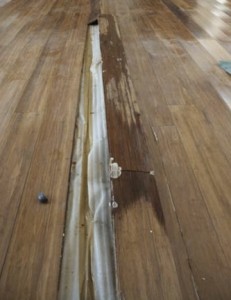 Water damage affects most flooring types, even tiles.
Water damage affects most flooring types, even tiles.
Bamboo is very resilient to moisture – more so than most solid wood floors. But bamboo, just like wood is hygroscopic, so it absorbs water, resulting in expansion. Too much water and permanent damage results.
As our experience shows that water damage is the most common cause for damage to bamboo flooring.
We wanted to share our experiences in the hope that these will help others prevent the pain and cost of a water damaged floor.
What are the common causes of water damage on a wood floor?
Water damage due to moisture in the sub-floor
The most common cause for water damage is when the underlying concrete sub-floor is not completely dry. When concrete dries, it dries from the outside towards the center core. So, often the concrete “looks’ dry, but is not.
Sometime completion deadlines on building projects do not allow enough time for the concrete to fully cure. Other times the water proof detailing is insufficient, allowing water to seep in from outside sources. These are both common causes for water damage.
Make sure your flooring installer tests the moisture content (MC) of the concrete. This can be done using a reliable and calibrated moisture meter. This meter should have a “concrete” setting for calibration. This will highlight any extra moisture resident in the slab (the acceptable limit is 5%), allowing corrective measures to be applied before installation of the flooring planks – preventing water damage.
This simple pre-installation step will prevent 99% of water damage to floors.
Water damage via moisture ingress through external access points
The next most common cause for water damage is when water comes in under the floor through doorways and other access points (e.g. wood floors adjacent to a bathroom or kitchen for example).
Overflowing baths (forgot that the bath water was still running) and burst dishwasher or washing machine pipes are a common cause of water damage.
Ensuring that the installer provides adequate waterproofing at all access points (including between the kitchen & bathroom common sections) will ensure no water seeps in under your bamboo floor.
It is also important to check with the installer that they use high quality water proofing products. Products that will not loose their effectiveness over time or exposure to the sun.
Lack of a moisture vapour barrier on the sub-floor
Most sub-floors are concrete. Concrete is also hygroscopic – it absorbs and exudes moisture. That means that if the concrete subfloor is exposed to moisture, it will absorb that moisture. It is for this reason that is is highly recommended that the installer apply a moisture vapour barrier between the sub-floor and the flooring. This can be a SABS 2.5 micron damp proofing membrane (DPM) or a paint on product such as Sika SikaFloor 156ZA or Bostik D250 or D261 (there are many other suitable products).
A moisture barrier may not always be necessary when the bamboo flooring is installed on a mezzanine or higher levels.
A moisture barrier will prevent moisture buildup directly under the flooring planks and prevent water damage to your floor.
If you have installed underfloor heating under your bamboo floor. We consider it mandatory to apply a paint-on moisture barrier (such as SikaFloor 156ZA) to the subfloor to prevent water damage. The reason for this is that the heat from the underfloor heating will dry out the slab. If there is any moisture in the slab or adjacent to it, the heat will “draw” the moisture to the surface via capillary action – directly under the flooring planks where it will accumulate. A top quality moisture barrier product will retard any moisture build up under the flooring planks and prevent water damage.
A few other resources: